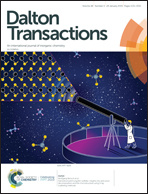Hydrophilic quaternary ammonium-group-containing [FeFe]H2ase models prepared by quaternization of the pyridyl N atoms in pyridylazadiphosphine- and pyridylmethylazadiphosphine-bridged diiron complexes with various electrophiles†
Abstract
The first aromatic quaternary ammonium-group-containing [FeFe]H2ase models have been prepared by a simple and convenient two-step method in high yields. Thus, on the basis of preparation of the N-pyridylazadiphosphine-bridged diiron complex (μ-PDT)Fe2(CO)4[μ-3-(Ph2P)2NC5H4N] (A) by CO substitution of parent complex (μ-PDT)Fe2(CO)6 with N-pyridylazadiphosphine 3-(Ph2P)2NC5H4N in refluxing xylene, further quaternization of the pyridyl N atom in complex A with electrophile 1,3-propanesultone, 1,3,2-dioxathiolane-2,2-dioxide, or 4-bromobutyric acid in refluxing MeCN afforded the pyridyl quaternary ammonium-group-containing models (μ-PDT)Fe2(CO)4[μ-3-(Ph2P)2NC5H4NR] (1, R = (CH2)3SO3; 2, R = (CH2)2OSO3) and (μ-PDT)Fe2(CO)4[μ-3-(Ph2P)2NC5H4N(CH2)3CO2H]Br (3). Similarly, the N-pyridylmethylazadiphosphine-bridged diiron complex (μ-PDT)Fe2(CO)4[μ-3-(Ph2P)2NCH2C5H4N] (B) could be prepared by CO substitution of parent complex (μ-PDT)Fe2(CO)6 with N-pyridylmethylazadiphosphine 3-(Ph2P)2NCH2C5H4N in refluxing xylene, while further quaternization of the pyridylmethyl N atom in complex B with 1,3-propanesultone and 3-bromo-1-propanol in MeCN at reflux resulted in formation of the pyridylmethyl quaternary ammonium-group-containing models (μ-PDT)Fe2(CO)4[μ-3-(Ph2P)2NCH2C5H4N(CH2)3SO3] (4) and (μ-PDT)Fe2(CO)4[μ-3-(Ph2P)2NCH2C5H4N(CH2)3OH]Br (5), respectively. All new complexes A, B, and 1–5 were characterized by elemental analysis and various spectroscopies, while the molecular structures of complexes A, B, 2 and 5 were further confirmed by X-ray crystallography. The electrochemical study on hydrophilic models 1 and 3 in MeCN and the MeCN/H2O mixed solvent indicated that the reduction potentials were shifted to less-negative potentials as the water content increased; such an observation implies that both 1 and 3 are easily reduced in the mixed MeCN/H2O solvent than in MeCN. In addition, the electrocatalytic study demonstrated that both 1 and 3 can serve as electrocatalysts for H2 production from acetic acid with higher icat/ip and TONs in MeCN/H2O than in MeCN.
![Graphical abstract: Hydrophilic quaternary ammonium-group-containing [FeFe]H2ase models prepared by quaternization of the pyridyl N atoms in pyridylazadiphosphine- and pyridylmethylazadiphosphine-bridged diiron complexes with various electrophiles](/en/Image/Get?imageInfo.ImageType=GA&imageInfo.ImageIdentifier.ManuscriptID=C8DT04211J&imageInfo.ImageIdentifier.Year=2019)


 Please wait while we load your content...
Please wait while we load your content...